 NYC-based PIRA Energy Group reports that recent Oklahoma wastewater directives not likely to have material impact on crude production. In the U.S., hefty crude imports propelled U.S. crude stocks higher. In Japan, crude runs recovered, imports rose and stocks built. Specifically, PIRA’s analysis of the oil market fundamentals has revealed the following:
NYC-based PIRA Energy Group reports that recent Oklahoma wastewater directives not likely to have material impact on crude production. In the U.S., hefty crude imports propelled U.S. crude stocks higher. In Japan, crude runs recovered, imports rose and stocks built. Specifically, PIRA’s analysis of the oil market fundamentals has revealed the following:
Hefty Crude Imports Propel U.S. Crude Stocks Higher
Recent crude import have averaged about 0.88 MMB/D higher than last year, roughly the same magnitude as the decline in domestic crude supply. Crude runs being about 550 MB/D higher have restrained the increase in crude stocks. Gasoline and jet demand have been growing, but distillate has been very weak. The gasoline balance sheet cleaning up relative to the distillate balance sheet is reflected in distillate prices weakening versus gasoline. Looking forward, a strong increase in CDU maintenance should reduce crude runs and contribute to another crude stock build. Gasoline demand and seasonally declining yields should drive a steeper-than-average draw, as distillate demand results in an average draw.
Potential Producing Region High Storage Alarm Bells
Though the books have only just opened for March, the month already may have seen its final double-digit withdrawal of the heating season. Preliminary balances suggest next week’s report will feature at best a minor withdrawal, followed by a sizable 30-40 BCF injection for the week ending March 18th. Consequently, U.S. balances are on pace to end the month with a storage position near ~2.5 TCF, a remarkably similar tally to end-February and the record set in 2012. Thursday’s reported draw also resulted in a steep expansion to 911 BCF in the year-on-year storage surplus. With additional gains looming, the overhang will soon top the 1 TCF threshold.
German Lignite Is Now Cash-Flow Negative
The latest earning calls by major power generators confirm PIRA's view that the Continental markets continue to be on an unsustainable path, with utilities now feeling increasing pressure from rating agencies (a sign of growing credit concerns). More specifically for Germany, the slump in commodity prices is keeping wholesale prices at historically lower levels, with current prices unable to cover large portions of the baseload fleet — lignite and nuclear. Going forward, while power prices may be stabilizing as a result of gains in oil and coal prices, the lack of retirements will continue to squeeze margins.
Coal Price Rebound Continues on Strike Risks and Higher Oil
Seaborne coal pricing generally moved higher last week, with a looming strike at the Cerrejón mine in Colombia and rising oil pricing providing some upward momentum to coal pricing. There is a fundamental rebalancing that is (slowly) going on, with some discipline on the supply side and strengthening on the demand side. This is expected to lead to a more structural recovery in pricing in late-2016 into 2017. Additionally, we believe that the coal market is underestimating the impact that a recovery in oil prices will have on coal production costs and pricing. PIRA retains a bullish outlook relative to the market starting in 4Q16.
RGGI Carbon Auction Reflects Lower Pricing
RGGI’s carbon allowance auction saw strong demand with compliance-oriented buying, but it cleared below the secondary market. PIRA continues to expect that this year’s Program Review process will result in a tightening of caps post-2020. Price volatility may also lead to consideration of a more robust price floor. The prospect of continued operation of Maryland coal units could mean higher-than-expected emissions.
The U.S. Exports First Ethane Cargo
The first ever long-range ethane cargo loaded last week at Sunoco’s Marcus Hook, PA, terminal in the Northeast United States. The cargo loaded and departed midweek (March 9th) and headed for its destination in Rafnes, Norway, where it is expected to arrive on March 29th. The JS Ineos Intrepid has a 172 MB (27.5 thousand cubic meter) cargo capacity. The ethane cargo will be used as feedstock for Ineos’s Norwegian petrochemical facility.
U.S. Output Declines
Despite a drop in U.S. ethanol production for the second consecutive week, stocks built by 683 thousand barrels to a record 23.3 million barrels. Total inventories are up a remarkable 2.1 million barrels from 21.2 million at this time last year.
Way Ahead of Schedule
Pictures of heading wheat the second week of March caused more than a little concern for many. The HRW crop was pushed way ahead of schedule with the recent warm snap and is now at risk of damage due to cold or wet conditions over the next month or so. The already massive short position obviously didn’t help either, and while we’re bearish flat price, it’s best to sit this one out.
Financial Stress Continues to Ease
For the fourth straight week, the S&P 500 rose Friday-to-Friday and on a weekly average basis. While volatility was little changed, all of the other indicators, such as high yield debt and emerging market debt, again posted solid gains. The U.S. dollar lost ground on the week against a host of currencies. Commodities ex-energy are looking significantly better the past several weeks (an eight-week uptrend). Energy has also moved higher the last few weeks.
Japanese Crude Runs Recovered, Imports Rose and Stocks Built
Crude runs recovered about one third of the decline posted the previous week. Crude imports rose sufficiently to build crude stocks 6.7 MMBbls. Finished product stocks drew, largely due to end-of-season kerosene stock declines and lesser draws in naphtha, gasoil, and gasoline. This was despite across-the-board demand declines in all the major products. The indicative refining margin remains good. This week saw higher gasoline and kero-jet cracks, while naphtha and fuel oil cracks eased.
Why Is TTF So Weak and What Does That Mean for Spreads Going Forward?
Gas price spreads around Europe are a series of levers. You push down on one side, spreads will open up. Push down on another, spreads will close. We are seeing this levering already at play on the TTF relative to other Continental European hubs and expect more, as increasing volumes of LNG dock on European shores. TTF is looking weak so far this March vs. nearly all N.W. European Hubs despite Groningen production dropping to historically low levels (for this time of year) and low LNG deliveries into the Dutch pipeline system. Storage, namely the 4 BCM Bergermeer facility, has really stepped up to fill the void created by lost production volumes. While these extra volumes don’t fully replace Groningen, between the historically low demand, extra storage volumes, more Norwegian volumes, and extra Russian volumes this difference has been made up.
Coal Supply Cuts Increase
While underlying demand conditions for coal — and natural gas prices — have weakened further, production cuts have accelerated. In addition, generators are turning more to “forced coal burn” in order to assist in trimming burgeoning inventories. This is setting the stage for an expected normalization of market balances in 2017.
California Carbon Slipped Below Floor; Auction Decision Looms
Sharp declines observed in the CA ETS have seen secondary market prices dipping below the auction floor price, particularly for prompt delivery. More information regarding the validity of allowance auctions could come any day — even in the event of a negative decision, consigned allowance auctions could continue.
U.S. Refiners Paid over $1 Billion in RIN Costs in 2015
U.S. refiners paid 1.27 billion to comply with RFS2 last year.
Funds Keep Selling Corn
In a week when grains and oilseeds enjoyed noticeable price appreciation, corn participation was limited and one look at last week’s Commitment of Traders showed the reason as Funds just keep selling, seemingly oblivious to any possible planting disruption.
The Expanded Panama Canal Set to Open for Trade in 3Q16
The expanded Panama Canal will benefit U.S. exports of LPG and help support U.S. LPG prices. But for crude/condensate exports, VLCC exports around the Cape of Good Hope are still generally more attractive than Canal voyages.
LNG's Generation X Comes to Life
The specter of production shut-ins remains a constant whisper throughout the industry unless demand growth surges in the short term. Lower prices do suggest a lift in the demand curve is possible, but it is still difficult to place all of the world’s emerging LNG supply without an extremely low price that cracks open more coal-to-gas switching.
Global Equities Post Another Positive Week
Global equities posted a fourth straight week of gains. Many of the tracking indices continue to display significantly better looking trends. In the U.S., almost all the tracking indices were higher on the week. Energy, materials utilities, and retail did the best, while banking lagged. Internationally, the tracking indices were a bit more mixed. The best performers were Europe and Latin America. Japan, emerging Asia, and China lagged.
Ethanol Prices Slide
U.S. ethanol prices tumbled last week as inventories were near record highs. Manufacturing margins were stable as corn costs also declined.
What Ails U.S. Distillate Demand?
Weekly distillate demand has been running about 700 MB/D below forecast. PIRA has pointed to the adverse impact of a strong dollar on U.S. industry as well as the crippling impact of low commodity prices on mining as likely causes for this demand weakness. We estimate their combined negative impact on diesel demand is roughly 320 MB/D, leaving the remaining 380 MB/D to be explained by other factors such as bad weekly demand data. The recent 278 MB/D upward revision in the December PSM of the DOE weekly demand data is testimony to the kind of upward revisions that are possible. There will be more upward revisions to the weekly numbers when the PSM monthly data for January and February are released.
Will the Rio Olympics Help Brazil’s Economy and Oil Demand?
Historically, the summer Olympic games have tended to support economic activity in host countries, and there has also been a positive historical pattern between hosting the Olympics and oil consumption. This year, Rio de Janeiro will host the first Olympics in South America, but the typical Olympic effects on the economy and oil demand have not evident in Brazilian data. Recent encouraging signals from financial markets, however, suggest that the Olympic lift may materialize after all.
Egypt Reduce Gas Prices for Industrial Users
Egypt will reduce the price it offers natural gas to steel and iron factories, Minister of Industry Tarek Kabil told a news conference last Wednesday. The reduction brings gas prices for the industries back to their 2014 levels, before prices were hiked as part of a broader government plan to cut subsidies, including those to heavy industry. At the time, the government increased gas prices by 30-75%. Egypt in December relaxed a commitment made by the previous government to abolish subsidies on gasoline, diesel and natural gas, and said lower global oil prices and the discovery of a massive offshore gas field meant it could move more slowly on the pledge.
Recent Oklahoma Wastewater Directives Not Likely to Have Material Impact on Crude Production
On March 7th Oklahoma’s oil and gas regulatory body issued a directive to reduce the wastewater injected into disposal wells in an area covering 5,000 square miles and over 400 disposal wells. This follows on the heels of a directive issued on February 16th impacting over 200 wells. Both the February and March actions represent an expansion in scope from directives issued in the state over the past year. However, PIRA does not see a material impact on oil production. The directives are largely voluntary and aim to reduce water disposal, not production. At most, we estimate a potential impact of 30 MB/D of crude. But the actual impact will likely be much less as operators come up with other ways to dispose of produced water.
Iraq Oil Monitor, 1Q16
Rising insecurity and worsening regional tensions resulted in multiple attacks and a 25-day shutdown of the ~600 MB/D Iraq-Ceyhan pipeline from mid-February. In the south, rising tribal violence and organized crime could deter investment and slow oil development. Southern exports averaged nearly 3.3 MMB/D from November to February, but further gains will likely be difficult as 2016 investment plans were reportedly reduced from $23 to $9 billion. The KRG-Baghdad oil export deal remains effectively dead, and PM Abadi’s plans for a major cabinet reshuffle has the potential to alleviate months of political paralysis or intensify a power struggle within the government.
Growth-Friendly Policy Announcements from China and Europe
Economic targets announced at this week’s Chinese National People’s Congress pointed to a growth-friendly policy stance. But policymakers also paid attention to structural issues, such as reforming state-owned enterprises. Chinese economic data for January/February were mixed, and a slowing in industrial production growth is likely to alarm policymakers. Easing measures that the European Central Bank introduced this week went beyond markets’ expectations. Positive manufacturing data from Germany and the U.K. suggested that industrial activity in the developed world may be starting to turn around.
The information above is part of PIRA Energy Group's weekly Energy Market Recap - which alerts readers to PIRA’s current analysis of energy markets around the world as well as the key economic and political factors driving those markets.


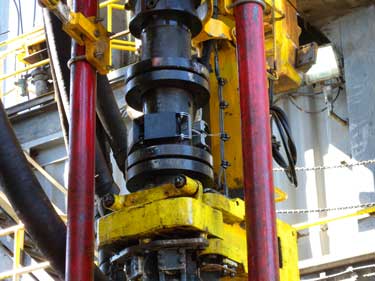 XACT Downhole Telemetry Inc.
XACT Downhole Telemetry Inc.
 NYC-based
NYC-based 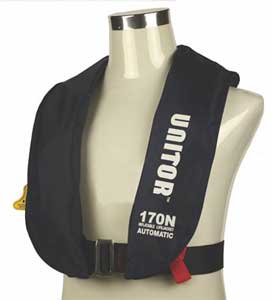
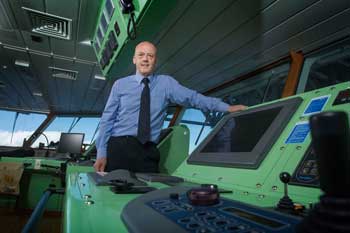 David Kerr, Managing Director
David Kerr, Managing Director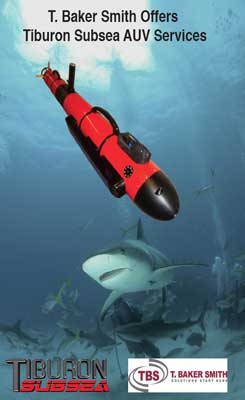
 In recent years, fishing communities in North West Europe have reaped numerous benefits from the rise of offshore wind – fishing vessels and their crews have been regularly employed for the transfer of technicians and equipment to wind farms off the coast. As the industry has evolved, there has been rapid growth in the use of purpose-build Personnel Transfer Vessels (PTV) for the same purpose. This remains a viable and low-cost option for many projects, but developers are now exploring innovative logistics solutions for rapid access to wind farms – the industry is modernizing rapidly and looking to the sky.
In recent years, fishing communities in North West Europe have reaped numerous benefits from the rise of offshore wind – fishing vessels and their crews have been regularly employed for the transfer of technicians and equipment to wind farms off the coast. As the industry has evolved, there has been rapid growth in the use of purpose-build Personnel Transfer Vessels (PTV) for the same purpose. This remains a viable and low-cost option for many projects, but developers are now exploring innovative logistics solutions for rapid access to wind farms – the industry is modernizing rapidly and looking to the sky.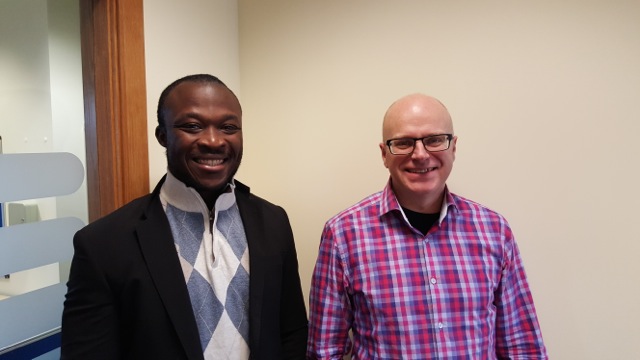 David Obatolu and Lee Dudbrige, IRMS UKWA
David Obatolu and Lee Dudbrige, IRMS UKWA iSURVEY Group, a leading provider of survey and positioning services to the global oil and gas and telecommunications sectors, has boosted its North Sea presence following a number of contract wins and the appointment of a new business development manager.
iSURVEY Group, a leading provider of survey and positioning services to the global oil and gas and telecommunications sectors, has boosted its North Sea presence following a number of contract wins and the appointment of a new business development manager.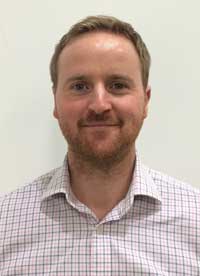 Stuart Murray, Business Development Manager
Stuart Murray, Business Development Manager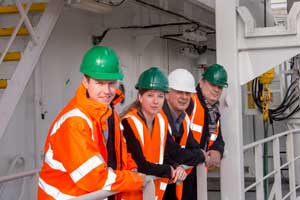 Left to right: Kees Wouters, Marine Project Supervisor; Jekaterina Mjackova, Marine Business Analyst, Eric Witton, Marine Manager; Loek Sakkers, Director Projects
Left to right: Kees Wouters, Marine Project Supervisor; Jekaterina Mjackova, Marine Business Analyst, Eric Witton, Marine Manager; Loek Sakkers, Director Projects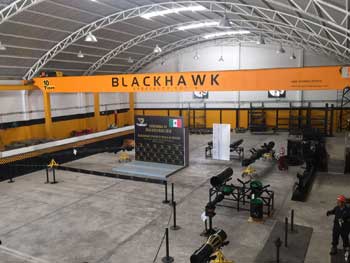
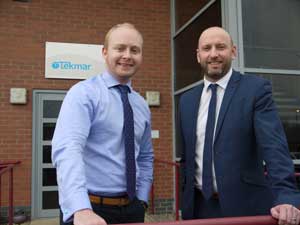 Tekmar Energy Ltd
Tekmar Energy Ltd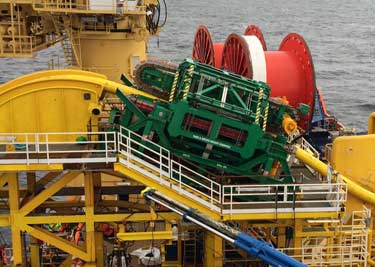 Sparrows Group
Sparrows Group Subsea IMR provider,
Subsea IMR provider, 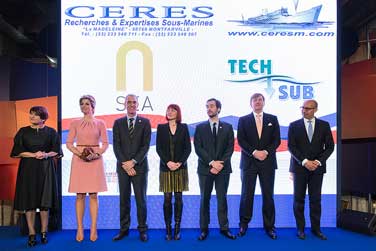 Representatives of N-Sea, CERES Recherches & Expertise Sous-Marine and TechSub Industrie Environement with the King and Queen of the Netherlands at the Dutch Trade Mission.
Representatives of N-Sea, CERES Recherches & Expertise Sous-Marine and TechSub Industrie Environement with the King and Queen of the Netherlands at the Dutch Trade Mission.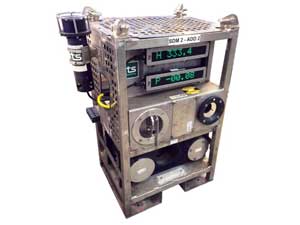
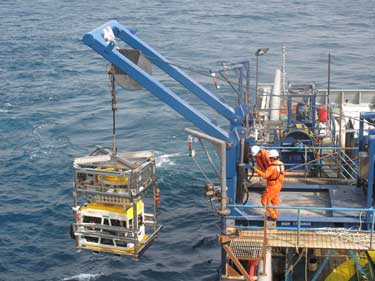 Horizon Geosciences
Horizon Geosciences